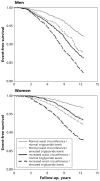The hypertriglyceridemic-waist phenotype and the risk of coronary artery disease: results from the EPIC-Norfolk prospective population study
- PMID: 20643837
- PMCID: PMC2942915
- DOI: 10.1503/cmaj.091276
The hypertriglyceridemic-waist phenotype and the risk of coronary artery disease: results from the EPIC-Norfolk prospective population study
Abstract
Background: Screening for increased waist circumference and hypertriglyceridemia (the hypertriglyceridemic-waist phenotype) has been proposed as an inexpensive approach to identify patients with excess intra-abdominal adiposity and associated metabolic abnormalities. We examined the relationship between the hypertriglyceridemic-waist phenotype to the risk of coronary artery disease in apparently healthy individuals.
Methods: A total of 21,787 participants aged 45-79 years were followed for a mean of 9.8 (standard deviation 1.7) years. Coronary artery disease developed in 2109 of them during follow-up. The hypertriglyceridemic-waist phenotype was defined as a waist circumference of 90 cm or more and a triglyceride level of 2.0 mmol/L or more in men, and a waist circumference of 85 cm or more and a triglyceride level of 1.5 mmol/L or more in women.
Results: Compared with participants who had a waist circumference and triglyceride level below the threshold, those with the hypertriglyceridemic-waist phenotype had higher blood pressure indices, higher levels of apolipoprotein B and C-reactive protein, lower levels of high-density lipoprotein cholesterol and apolipoprotein A-I, and smaller low-density lipoprotein particles. Among men, those with the hypertriglyceridemic-waist phenotype had an unadjusted hazard ratio for future coronary artery disease of 2.40 (95% confidence interval [CI] 2.02-2.87) compared with men who did not have the phenotype. Women with the phenotype had an unadjusted hazard ratio of 3.84 (95% CI 3.20-4.62) compared with women who did not have the phenotype.
Interpretation: Among participants from a European cohort representative of a contemporary Western population, the hypertriglyceridemic-waist phenotype was associated with a deteriorated cardiometabolic risk profile and an increased risk for coronary artery disease.
Figures


References
-
- Després JP, Lemieux I. Abdominal obesity and metabolic syndrome. Nature. 2006;444:881–7. - PubMed
-
- Lemieux S, Prud’homme D, Bouchard C, et al. Sex differences in the relation of visceral adipose tissue accumulation to total body fatness. Am J Clin Nutr. 1993;58:463–7. - PubMed
-
- Pischon T, Boeing H, Hoffmann K, et al. General and abdominal adiposity and risk of death in Europe. N Engl J Med. 2008;359:2105–20. - PubMed
Publication types
MeSH terms
Substances
Grants and funding
LinkOut - more resources
Full Text Sources
Medical
Research Materials
